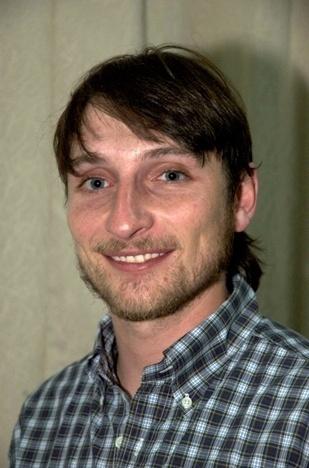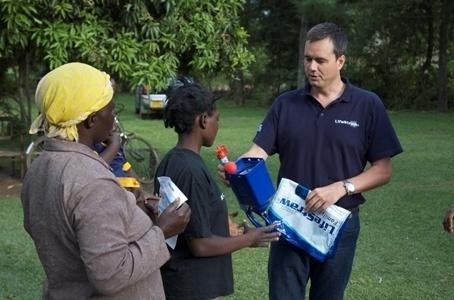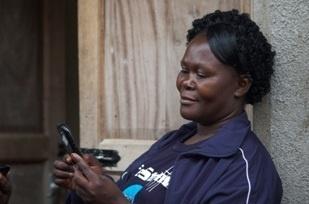Cell phone technology is taking a lead role in supporting the provision of clean, potable water to four million Kenyans. Stephen Williams spoke to Manna Energy’s CTO, Max Gold to learn more
In Kenya’s Western Province, a groundbreaking ‘Carbon for Life’ programme is distributing, free of charge, highly efficient water filters to rural homes.
Called the Family LifeStraw, it is a simple to operate, gravity fed device that cleans even the most putrid water to EPA standards – that is, the filtered water is cleaner than bottled mineral water.
But the most remarkable thing is the business model behind the programme.
What makes the Carbon for Life initiative so innovative is that the Swiss-based company behind it, Vestergaard Frandsen (VF) receives no government or public sector funding but is recouping its capital outlay by earning carbon credits for saving the biomass that rural people use to boil and purify water.
In February, the company’s Carbon for Water programme, possibly the largest privately financed water treatment programme in history, received its carbon credit approval – the first that directly links carbon credits with safe drinking water.
Critical to this approval has been VF’s partnership with Manna Energy Ltd, a market leading company in combining multi-billion dollar carbon finance markets with sustainable development and appropriate technologies, and who have extensive experience in developing robust, appropriate technologies that integrate data monitoring systems for continuous performance reporting.
Linking up with VF, Manna Energy have designed and implemented the monitoring system that allowed the Carbon for Life programme to receive carbon credit approval in February 2011 and start the six-week roll out of 900,000 filters in late April.
 “We created an application on Google android phones based on a software package called the Open Data Kit (ODK), developed by the University of Washington in the US,” Manna Energy’s Max Gold said.
“We created an application on Google android phones based on a software package called the Open Data Kit (ODK), developed by the University of Washington in the US,” Manna Energy’s Max Gold said.
“The ODK is an open source data collection platform and what we’ve done is modify that fairly significantly for this project, allowing the people who are out on the field, the distributors and their supervisors, to send data back to our server that records the project’s progress.”
The Carbon for Life programme is critically important as water-borne diseases are a severe threat in many parts of Africa.
They represent a gruesome spectrum of deadly ailments ranging from parasitic worms to typhoid, diarrhoea and cholera. Even if they do not kill, they weaken the body so badly that other diseases, such as malaria, take a far greater toll.
According to 2010 World Health Organization data, almost one billion people in the world lack access to safe drinking water.
One of the more desperate statistics is how the lack of clean water impacts the weakest.
It is estimated that 85 per cent of all illnesses that afflict under-fives in Africa are water-borne.
Diarrhoeal disease is the second leading cause of death in children under five years old, after pneumonia, and is responsible for killing 1.5mn children every year.
While there are a number of commercial operators that sell water filters, there are water filters that are distributed free of charge.
It is the brainchild of Mikkel Vestergaard Frandsen, a Danish-born entrepreneur who now runs the eponymous family business.
But VF is no charitable foreign non-governmental organisation – it is a profit-making company that exercises what it describes as ‘Humanitarian Entrepreneurship’.
Gold said that every one of the 4,000 local supervisors and 40,000 local representatives that are distributing the Family LifeStraw door-to-door in the Western Province are equipped with a US$160 Samsung Galaxy 5, variously known around the world as the Samsung I 5500 and Samsung I 5503, but sold in Kenya as the Galaxy 5.
Part of the deal is that the distributor receives not only a salary but gets to keep the phone at the end of the distribution roll-out.
“The main piece of data that is coming in via the cell phones is what is most important in order to validate this project through the Gold standard carbon credit terminology,” said Gold.
“They need very rigorous proof of exactly how many water filter units were installed so that the calculation can be performed on how many carbon credits should be awarded for the biomass fuel saved.
“So the data includes a photograph of the installation and the owner and that helps us validate unique installations with unique people every time. In addition to the GPS, photographs also have the names of the person that have been supplied with the LifeStraw unit.
“The distributors send their daily inventory information back to the server and we can check to make sure that we are on track.
“When the validator comes out to Kenya, they can go visit any installation these might choose, locating them by the GPS coordinates and they can say, ‘Okay, this person from the picture has a LifeStraw, there’s this many people in the household, so it checks out’.
This data allows the validation process to go a lot more smoothly than it would be on paper forms and it’s much easier to get it across to the validator so that it can be checked.”
The data is also useful to VF for follow-up repairs and maintenance.
After the roll-out is complete, the company plans setting up at least 30 repair and replacement centres across the province.
The LifeStraw should ideally be replaced every three years of normal household use, and VF plans to be in the province for at least 10 years before handing over to a local operating company.
“We can call people up and then remind them of the maintenance cycle,” Gold said. “And we double-check a random sample of the installations to make sure that the distributors actually put the Family LifeStraw up properly and explained how to use them.”
 Mikkel Vestergaard Frandsen said that, “If the ‘Carbon for Water’ programme can become a model for significantly reducing diarrhea and respiratory diseases, it will be a home run for the people of Kenya and many other developing countries for achieving the UN’s Millennium Development Goals [MDGs] four, five, six and seven”.
Mikkel Vestergaard Frandsen said that, “If the ‘Carbon for Water’ programme can become a model for significantly reducing diarrhea and respiratory diseases, it will be a home run for the people of Kenya and many other developing countries for achieving the UN’s Millennium Development Goals [MDGs] four, five, six and seven”.
These four MDG goals are to reduce child mortality; to improve maternal health; to combat diseases; and to ensure environmental sustainability.
Frandsen said, “Water point-of-source solutions [such as boreholes and wells] are often not completed because of bureaucratic gridlock or break down due to a lack of maintenance.
“Point-of-use solutions, such as the Family LifeStraw, are widely seen by academic researchers as the most effective intervention to deliver safe drinking water”.
The way that Carbon for Life is utilising mobile technology for social development and public health is one more example of how the cell phone has transformed Africa, but Gold is realistic enough to plan for every contingency.
“We’re using 2G networks because there is not much 3G around,” he said.
“And we’ve planned ahead for connectivity problems knowing that cell phone networks are not always reliable, especially in rural areas.
“So all the data can be recorded and, in the case of connectivity problems, backed-up on the phones.
“If the network is out it’s all saved in the phone, and when the network comes back it uploads by itself. That’s how we handle network issues.”
“So even if the network were to go down for the entire day, or for a month, the project would still have the data because it comes in from the phones when the network is back up.”
Currently, the database is being hosted by Google, which Gold says is really affordable as the total budget for the use of the Google server is only $1,000.
“Google cloud services are fantastic,” he claimed, “and really ahead of the rest.”
When the distribution target is met, the database is going to be around 200GB and will be kept permanently on the Vestergard server.
“The data supplies an accurate report,” says Gold, “and you get to see all the data from the area over, for example over a particular time period, or you can view all the pictures from the whole project. It will answer any kind of query, and the validators are able to cross check our data with what they see on the ground.”
The economic impact of VF’s Carbon for Water programme is potentially profound, and it has been made possible by leveraging mobile technology to improve the general health of the population, and the ability of children to go to school, adults to go to work, and freeing up capacity and scarce resources in the country’s hospitals.





















